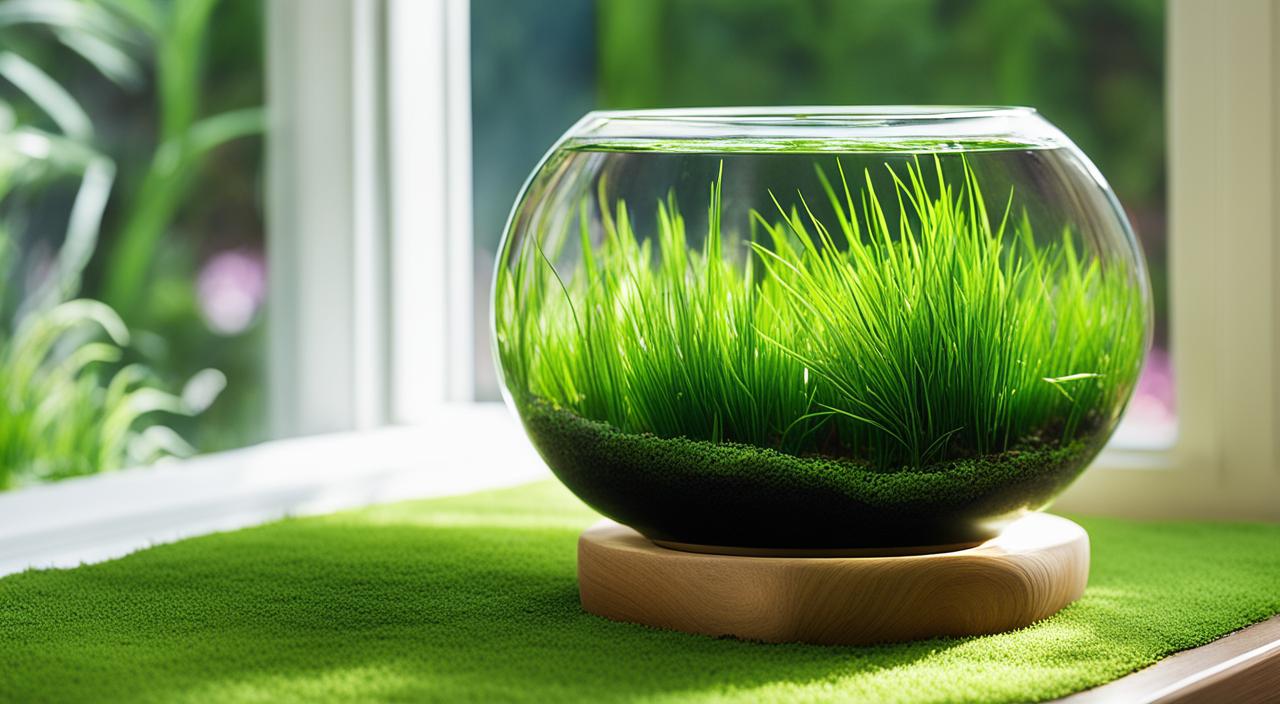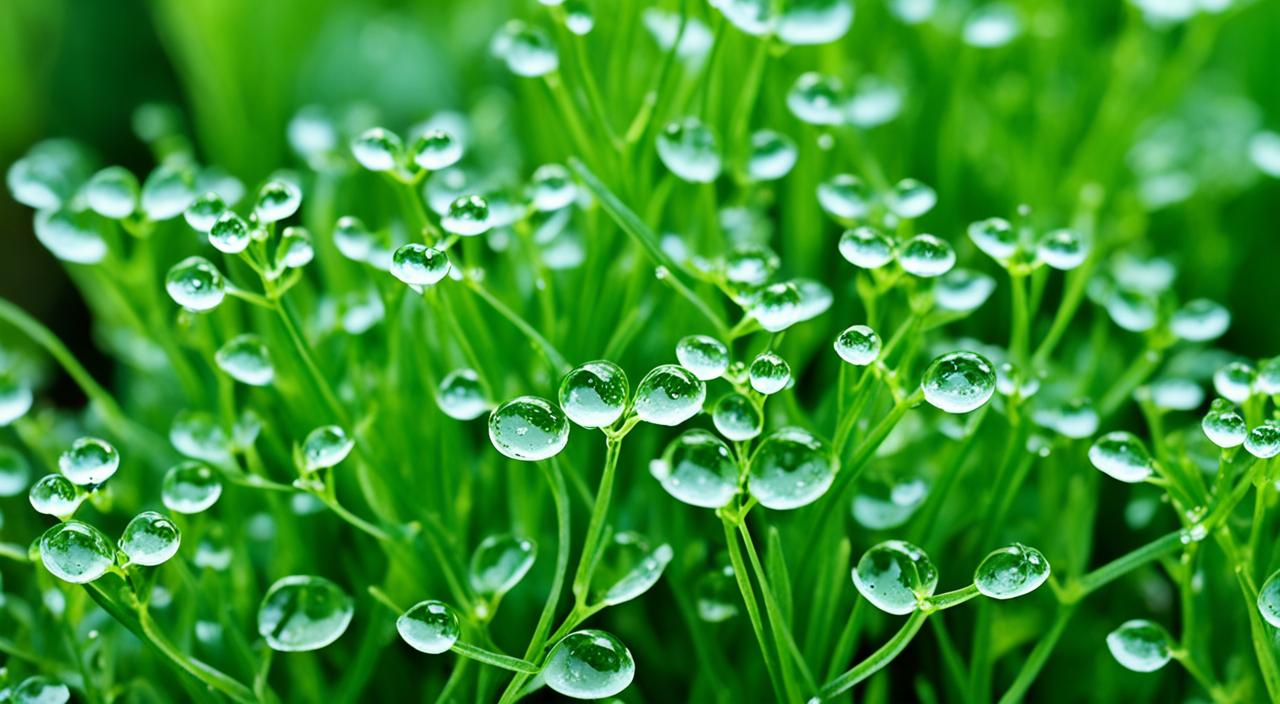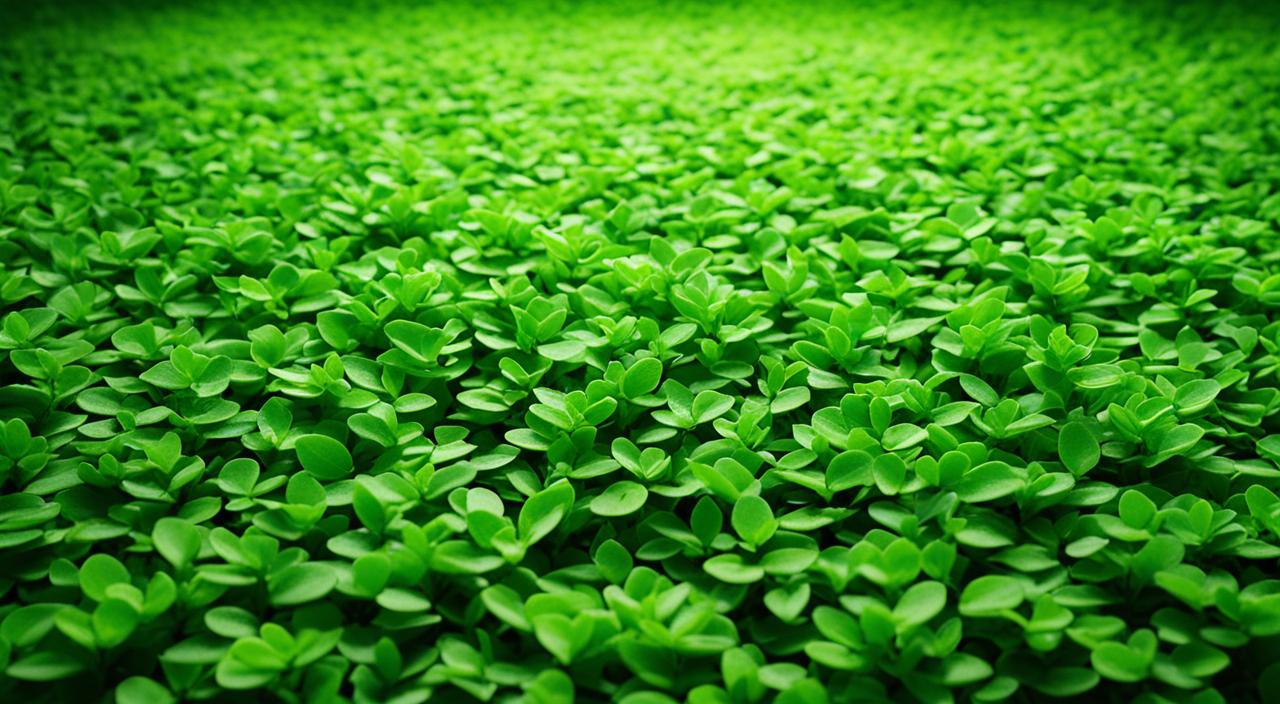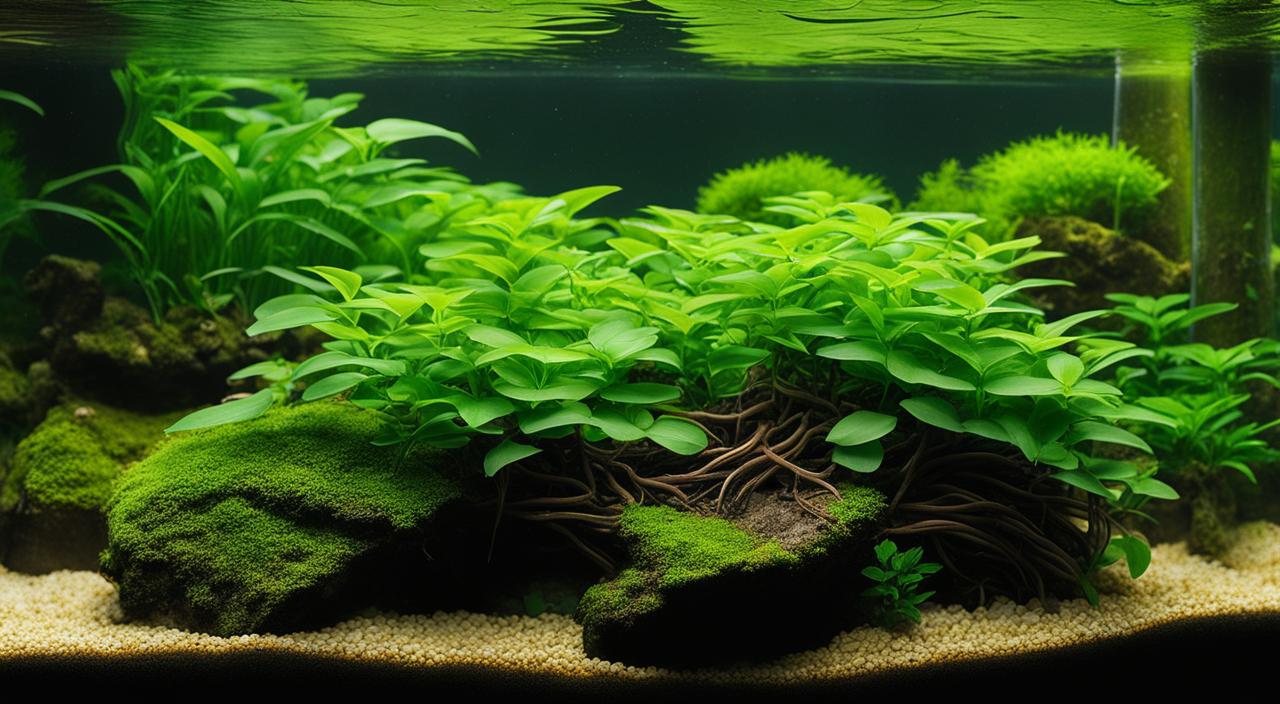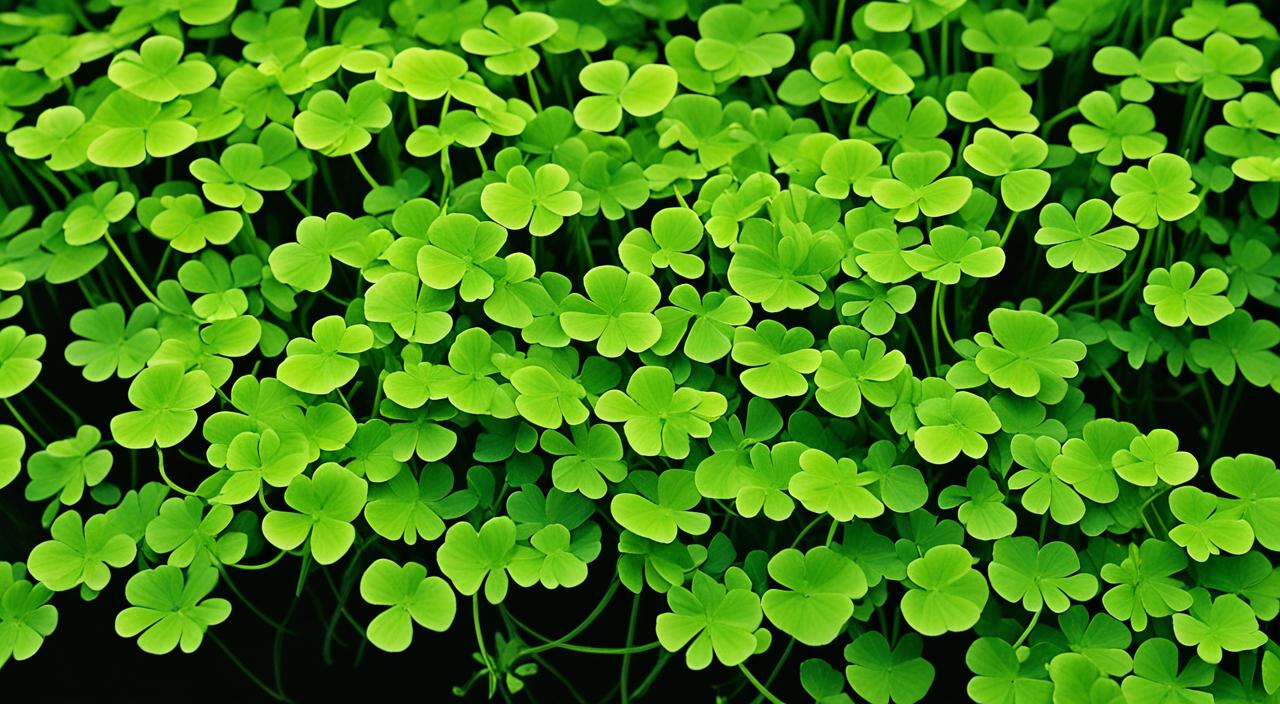Welcome to my comprehensive guide on caring for Dwarf Hairgrass (Eleocharis parvula), a widespread aquatic plant in freshwater aquascaping. This versatile plant is a fantastic choice if you want to create a lush and vibrant carpet in your aquarium. In this article, I will provide all the information you need to successfully care for Dwarf Hairgrass, from its origins and habitat to its morphological characteristics and ideal placement. Whether a beginner or an experienced aquarist, this guide will help you create a stunning and thriving aquariumscape with Dwarf Hairgrass.
Key Takeaways:
- Dwarf Hairgrass, or Eleocharis parvula, is a popular aquatic plant that can create a beautiful carpet effect in freshwater aquariums.
- Proper lighting, placement, and care parameters are essential for the successful growth of Dwarf Hairgrass.
- When choosing tank mates for Dwarf Hairgrass, select peaceful species that won’t damage the delicate carpeting plant.
- Feeding, fertilisation, and CO2 injection can promote healthy growth and vibrant colouration in Dwarf Hairgrass.
- Regular maintenance and attention to water quality are crucial for the long-term health of Dwarf Hairgrass.
Now, let’s dive deeper into Dwarf Hairgrass and discover everything you need to know to cultivate this stunning aquarium carpet plant.
Brief Overview of Dwarf Hairgrass (Eleocharis parvula)
Dwarf Hairgrass, also known as Eleocharis parvula, is a freshwater aquatic plant species belonging to the Cyperaceae family. It is a popular choice for creating a carpet-like effect in aquariums due to its short and dense growth habit. This versatile plant is low-maintenance and can thrive in various aquarium setups. Proper lighting is essential for promoting healthy growth in Dwarf Hairgrass, and it is crucial to provide sufficient illumination to ensure photosynthesis can occur.
Dwarf Hairgrass (Eleocharis parvula) Information Table:
| Attribute | Description |
|---|---|
| 1. Scientific Name: | Eleocharis parvula |
| 2. Common Names: | Dwarf Hairgrass, Mini Hairgrass |
| 3. Origin: | Worldwide distribution in marshy environments |
| 4. Height: | 2-10 cm (0.8-4 inches) |
| 5. Growth Rate: | Moderate to Fast |
| 6. Colour: | Bright green |
| 7. Aquarium Placement: | Moderate to distribution of nutrients and CO2 evenly |
| 8. Water Type: | Freshwater |
| 9. pH: | 6.5 – 7.5 |
| 10. Care Level: | Moderate |
| 11. Light Requirements: | High; LUX: 2000-5000, PAR: 40-70 µmol/m²/s, Kelvin: 5000-7000K for optimal growth |
| 12. CO2 Requirements: | Recommended for robust growth, but can grow slowly without it |
| 13. Temperature: | 20-26°C (68-79°F) |
| 14. Flow Rate: | Moderate to the distribution of nutrients and CO2 evenly |
| 15. Propagation: | Runners |
| 16. Feed Type: | Root tabs and liquid fertilizers, rich in iron and micronutrients |
The light requirements for Dwarf Hairgrass are particularly crucial for its growth and development. A high LUX (2000-5000) and PAR (40-70 µmol/m²/s) are recommended to ensure the plant receives enough light energy for photosynthesis. The Kelvin scale, ideally between 5000-7000K, provides a spectrum that supports healthy growth and mimics natural daylight conditions, promoting the lush, carpet-like appearance that Dwarf Hairgrass is known for.
Origins and Habitat
Dwarf Hairgrass, or Eleocharis parvula, is a ground cover plant native to North America. It can be found in brackish and freshwater environments, specifically mudflats and marshes. While it is primarily found in North America, Dwarf Hairgrass is distributed in Europe, South America, and Asia, albeit to a lesser extent. This highly adaptable plant can tolerate various temperatures, making it a versatile choice for freshwater aquascaping.
By understanding the origins and natural habitat of Dwarf Hairgrass, aquarists can better recreate its ideal conditions in their aquariums. Creating a suitable environment that mimics the plant’s native habitat is essential for its growth and overall health. Whether you are planning to incorporate Dwarf Hairgrass into your aquascape or considering other ground cover plants, it is crucial to research and replicate the natural conditions in which they thrive.
Morphological Characteristics
Dwarf Hairgrass (Eleocharis parvula) is known for its unique morphological characteristics, making it a popular choice among aquarists. This aquatic plant features thin, hair-like blades that closely resemble terrestrial lawn grass. Its delicate appearance adds a touch of elegance to any aquarium, creating a visually appealing aquatic landscape.
One of the notable traits of Dwarf Hairgrass is its ability to form dense carpets in aquariums. It achieves this through its runners, which are long, horizontal stems that extend along the substrate. These runners give rise to new plants, gradually spreading and covering the entire aquarium floor with a vibrant green carpet.
Various factors, including lighting, nutrient availability, and carbon dioxide levels, influence the growth of Dwarf Hairgrass. It thrives in high-light aquatic environments, making it an excellent choice for aquariums with strong lighting setups. Adequate lighting ensures the plant receives the energy for photosynthesis, promoting healthy growth and vibrant colouration.
In addition to lighting, providing the proper nutrients is crucial for developing Dwarf Hairgrass. Aquarists can use root tabs or liquid fertilizers formulated explicitly for aquarium plants to ensure that this aquatic plant receives the necessary nutrients. CO2 injection also benefits its growth, as carbon dioxide is a critical component in photosynthesis.
Understanding the morphological characteristics of Dwarf Hairgrass is essential for creating optimal conditions in the aquarium. Aquarists can ensure the robust growth and propagation of this beautiful aquatic plant by providing adequate lighting, nutrient supplementation, and carbon dioxide.
Placement and Lighting
Proper placement and lighting are crucial for the successful cultivation of Dwarf Hairgrass. This plant should be planted in sufficient light to facilitate photosynthesis. Adequate lighting ensures that Dwarf Hairgrass maintains its vibrant green colour and promotes healthy growth.
Regarding placement, Dwarf Hairgrass is often used as a foreground or carpeting plant in aquascapes. It creates a lush and natural look, resembling a grassy meadow in the aquarium. To achieve the best results, it is recommended to plant Dwarf Hairgrass in the front or middle portion of the tank, where it can receive optimal lighting.
In terms of lighting requirements, Dwarf Hairgrass thrives under high-light conditions. It requires intense illumination to support its growth and ensure proper photosynthesis. LED or fluorescent light fixtures with a colour temperature of around 6500K are suitable for providing the necessary light intensity. It is important to note that inadequate lighting can result in poor growth and discoloured leaves.
When setting up the lighting for your aquarium, consider factors such as the depth of the tank and the presence of other plants or decorations that may obstruct light penetration. Placing the lighting fixture closer to the water surface can help maximize the light output received by the Dwarf Hairgrass.
Additionally, it is vital to maintain a consistent lighting duration. A recommended photoperiod for Dwarf Hairgrass is 8 to 10 hours per day. Providing a regular light-dark cycle simulates the natural conditions and promotes healthy growth.
What Are Good Tank Mates?
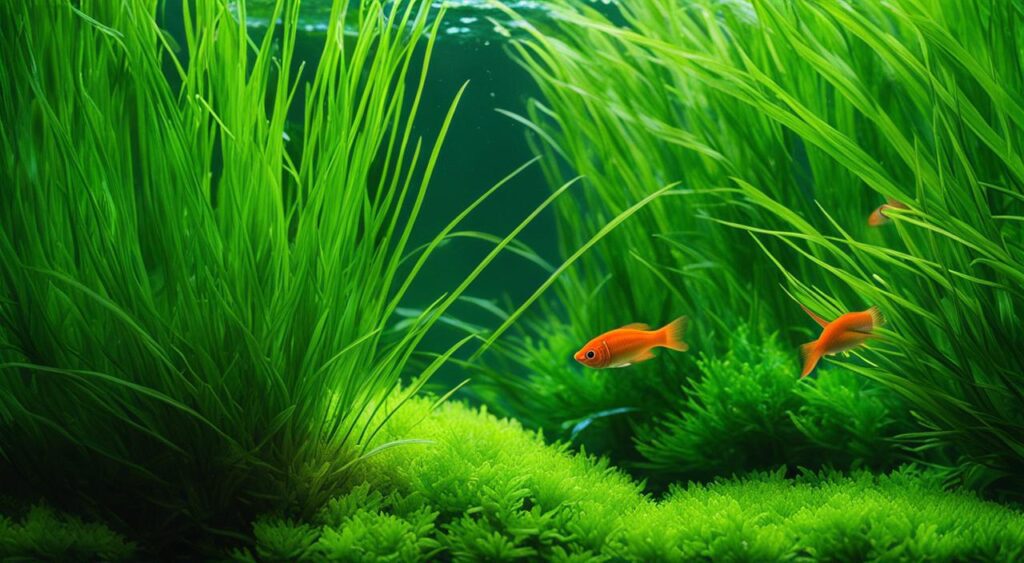
When selecting tank mates for Dwarf Hairgrass, it is important to choose species that will not damage or uproot the delicate carpeting plant. Good tank mates for Dwarf Hairgrass include small, peaceful fish and invertebrates that will not disturb the substrate. However, certain fish species should be avoided due to their destructive behavior or incompatible water parameters.
Good Tank Mates
Here are some suitable tank mates for Dwarf Hairgrass:
- Neon Tetras
- Dwarf Gouramis
- Cherry Shrimp
- Otocinclus Catfish
Fish Species To Avoid
It is recommended to avoid the following fish species as tank mates for Dwarf Hairgrass:
- Goldfish (large and active fish that may dislodge the plants)
- Cichlids (known to uproot plants)
- Red-tailed Sharks (aggressive and may damage the carpeting plants)
Feeding (Fertilization)
Proper fertilization is essential for the optimal growth and health of Dwarf Hairgrass. While this aquatic plant obtains nutrients through its roots, additional fertilization can promote vibrant colouration and lush growth. Understanding how much and how often to feed Dwarf Hairgrass is crucial to prevent nutrient deficiencies or excesses that can lead to algae growth and poor plant health.
It’s important to strike a balance when it comes to aquarium plant fertilization. Providing the right amount of nutrients will support healthy growth without causing harm. Here are some guidelines to follow:
How Much to Feed
Dwarf Hairgrass benefits from a regular supply of essential nutrients. You can provide these nutrients using a liquid fertilizer formulated explicitly for aquarium plants. Follow the dosage instructions provided by the manufacturer, taking care not to overdose the fertilizer. Generally, a dose of 1-2 millilitres per 10 gallons of water every week should be sufficient. Adjust the dosage based on the specific needs of your aquarium and the growth rate of the hair grass.
How Often to Feed
Consistency is critical when it comes to feeding Dwarf Hairgrass. It’s recommended to fertilize your aquarium once a week to ensure a steady supply of nutrients. This regular schedule will help support healthy growth and prevent nutrient fluctuations that can lead to algae issues.
Remember to monitor your aquarium water parameters regularly to ensure the right balance of nutrients. Adjust your fertilization schedule and dosage as needed based on the plant’s growth and the condition of your aquarium.
CO2 Injection
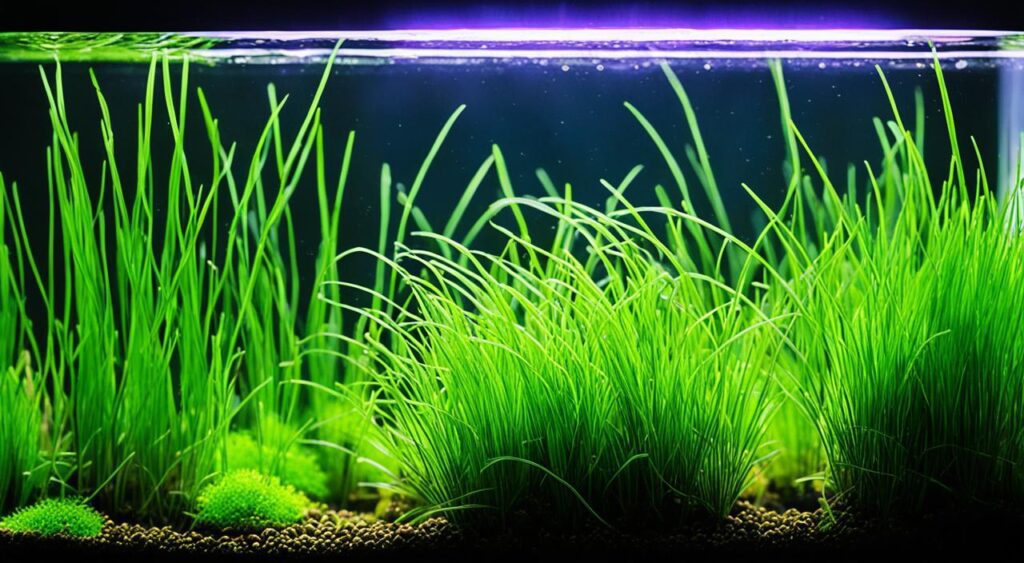
In order to enhance the growth of Dwarf Hairgrass and other aquatic plants in a planted aquarium, carbon dioxide (CO2) injection is commonly employed. CO2 is a crucial element in photosynthesis, and supplementing the tank with additional CO2 can result in faster and denser growth of plants like Dwarf Hairgrass. There are different types of CO2 injection methods available to aquarists, each with its own pros and cons.
Types of CO2 Injection
1. DIY CO2 Systems: Some aquarists use readily available materials to create their CO2 injection systems. This approach allows for flexibility in adjusting the CO2 levels based on the specific needs of the planted tank. However, DIY systems may require frequent maintenance and monitoring to ensure a consistent CO2 supply.
2. Pressurized CO2 Systems: Pressurized CO2 systems offer a more controlled and precise method of CO2 injection. These systems typically consist of a CO2 cylinder, regulator, and diffuser. Pressurized systems are easy to set up and maintain, providing a stable and reliable source of CO2 for consistent plant growth.
3. Liquid Carbon Supplements: Liquid carbon supplements, or liquid CO2, are alternative gas injection methods. These supplements contain organic compounds that plants can utilize as a carbon source. While liquid carbon supplements can promote plant growth, they may not be as effective as gas injection methods in stimulating the optimal development of demanding plants like Dwarf Hairgrass.
Care
Planted Tank Parameters
Creating and maintaining the proper parameters in a planted tank is essential for the health and well-being of Dwarf Hairgrass and other aquatic plants. Consider the following factors when setting up your planted tank:
- Lighting: Provide adequate lighting to support photosynthesis and promote healthy growth. Choose a light source suitable for planted aquariums and adjust the lighting duration to mimic natural daylight.
- Substrate: Use a nutrient-rich substrate designed explicitly for planted aquariums. This will provide essential nutrients for the root system and support strong plant growth.
- CO2 Injection: Consider supplementing CO2 levels in your tank, especially if you have high-light intensity or fast-growing plants. CO2 injection can enhance plant growth and vitality.
- Nutrient Supplements: Monitor and supplement essential nutrients, such as nitrogen, phosphorus, and potassium, as needed. This will ensure your plants have access to the nutrients necessary for healthy growth.
- Water Circulation: Maintain proper water circulation to prevent stagnation and promote nutrient distribution. Consider using a circulation pump or strategically positioning your filter outlet to achieve adequate water flow throughout the tank.
Water Quality
High-quality water is crucial for the overall health of your aquarium and its inhabitants, including Dwarf Hairgrass. Consider the following water quality parameters:
- pH Level: Aim for a slightly acidic to neutral pH level, around 6.0-7.5, to create a favourable environment for the growth of Dwarf Hairgrass.
- Temperature: Maintain a stable water temperature within the recommended range for the fish and plants in your tank. Dwarf Hairgrass thrives in water temperatures between 70-83°F (21-28°C).
- Ammonia and Nitrite Levels: Regularly test and monitor ammonia and nitrite levels in your tank. These compounds are toxic to aquatic life and can harm plants and fish. Aim for undetectable levels of ammonia and nitrite.
- Nitrate Levels: Keep nitrate levels low, ideally below 20 ppm, to prevent excessive algae growth and promote healthy plant growth.
Filtration
Effective filtration is crucial for maintaining water clarity and removing harmful substances from your tank. Consider the following filtration tips:
- Choose a filter that provides adequate mechanical, chemical, and biological filtration. This will help remove debris, toxins, and excess nutrients from the water column.
- Regularly clean and maintain your filter to ensure optimal performance. Follow the manufacturer’s instructions for cleaning and replacing filter media.
- Consider adding additional filter media, such as activated carbon or biological filter media, to enhance the filtration capabilities of your system.
Flow
Proper water flow is essential for maintaining a healthy planted tank. Consider the following tips for achieving optimal flow:
- Position your filter outlet to promote gentle water movement throughout the tank. Avoid creating strong currents that may uproot or damage your plants.
- Use a circulation pump or powerhead to improve water flow in areas of your tank with low water movement.
- Monitor your tank to ensure no stagnant areas where debris can accumulate. Adequate flow will help prevent algae growth and promote better nutrient distribution.
Aquarium Maintenance
Proper maintenance is essential for your aquarium’s long-term health and vitality, especially when it comes to keeping aquatic plants like Dwarf Hairgrass thriving. In this section, I will guide you through the critical aspects of aquarium maintenance that are crucial for the success of your planted tank.
Testing Water Conditions
Regularly testing the water conditions in your aquarium is vital for ensuring optimal plant growth and overall aquarium health. You can identify any imbalances or potential issues early by monitoring parameters such as pH, ammonia, nitrite, and nitrate levels. Implementing a testing regimen will help you make necessary adjustments to maintain the ideal water conditions for your Dwarf Hairgrass and other aquatic inhabitants.
How to Set Up Your Aquarium Tank
When setting up your aquarium tank for Dwarf Hairgrass, there are a few key steps to ensure a successful environment for your plants to thrive. Start by carefully choosing the appropriate substrate, such as aquarium soil or sand, which will provide essential nutrients to the roots of your Dwarf Hairgrass. Next, consider installing a reliable filtration system to maintain water clarity and remove harmful substances. Additionally, setting up a lighting system with the appropriate spectrum and intensity is crucial for supporting photosynthesis and promoting healthy plant growth.
Propagation Methods
Propagation is an excellent way to expand your Dwarf Hairgrass carpet or share it with fellow hobbyists. There are several methods you can use to propagate Dwarf Hairgrass, including:
- Runners: Dwarf Hairgrass produces runners that can be carefully separated from the mother plant and replanted in other aquarium areas.
- Division: As the plant spreads, clumps of Dwarf Hairgrass can be divided into smaller portions, each containing roots and shoots and replanted.
- Trimming: Regularly trimming the tops of your Dwarf Hairgrass can promote lateral growth and encourage the plant to fill in any bare spots.
By employing these propagation methods, you can achieve a dense and lush carpet of Dwarf Hairgrass in your aquarium.
| Aspects of Aquarium Maintenance | Importance |
|---|---|
| Regular testing of water conditions | Crucial for maintaining optimal plant growth and overall aquarium health |
| Proper setup of the aquarium tank | Creates a favourable environment for Dwarf Hairgrass and other aquatic plants |
| Propagation methods | Allows for expansion of the Dwarf Hairgrass carpet and sharing with other aquarists |
Health and Disease
Dwarf Hairgrass, like any living organism, is susceptible to health issues and disease. Aquarists need to be able to assess the health of their Dwarf Hairgrass and identify signs of good and poor health. Additionally, common health issues that may arise and their appropriate treatment methods will be discussed. Finally, measures to control and prevent plant pests that can affect the overall health and appearance of Dwarf Hairgrass will also be addressed.
Signs of Good Health
When Dwarf Hairgrass is in good health, there are several signs to look out for. These include:
- Lush and vibrant green colouration
- Dense carpet-like growth
- Strong root system
- No signs of wilting or yellowing
Signs of Poor Health
If Dwarf Hairgrass is experiencing poor health, there may be visible signs that indicate the plant is not thriving. These signs may include:
- Pale or yellowing leaves
- Stunted or slow growth
- Wilting or drooping foliage
- Root rot or decay
Common Health Issues and Treatment
Dwarf Hairgrass can encounter various health issues, and it is essential to be able to identify them and provide appropriate treatment. Some common health issues that may affect Dwarf Hairgrass include:
- Nutrient deficiencies: Lack of essential nutrients can lead to poor growth and colouration. Fertilizer supplementation can help address nutrient deficiencies.
- Algae overgrowth: Excessive algae growth can be detrimental to Dwarf Hairgrass. Proper lighting, nutrient balance, and regular maintenance can help control algae.
- Fungal or bacterial infections: Infections can cause visible deterioration of the plant, including rotting leaves or stems. The use of appropriate fungicides or bactericides may be necessary to treat diseases.
Plant Pests
Plant pests can negatively impact the health and appearance of Dwarf Hairgrass. Some common plant pests that may affect this plant include:
- Snails: Snails can consume plant foliage and damage the carpets created by Dwarf Hairgrass. Physical removal or the use of snail control methods may be necessary.
- Algae-eating fish: While beneficial for controlling algae, some algae-eating fish may also nibble on Dwarf Hairgrass, causing damage. Careful selection of compatible fish species is important to prevent this issue.
- Other plant-eating invertebrates: Certain invertebrates, such as crayfish or shrimp, may feed on Dwarf Hairgrass. Consideration should be given to appropriate tank mates to prevent damage to the plant.
Summary
Throughout this article, we have explored the fascinating world of Dwarf Hairgrass (Eleocharis parvula) and its care requirements. As a popular choice for freshwater aquariums, Dwarf Hairgrass is known for its ability to create lush, green carpets, adding beauty and dimension to aquascapes.
In summary, when caring for Dwarf Hairgrass, it is important to consider several key factors. First, proper lighting is crucial for its growth and health. Providing sufficient illumination promotes photosynthesis and helps maintain vibrant coloration. Additionally, placement within the aquarium is essential, ensuring that the plant receives adequate light and room to spread through its runners.
When choosing tank mates, it is important to select small, peaceful fish and invertebrates that won’t damage the delicate carpet. Avoid species known for uprooting plants or those with incompatible water parameters. Furthermore, maintaining water quality, including proper filtration and flow, is essential for the overall well-being of Dwarf Hairgrass.
Finally, keeping an eye on the plant’s health is vital. Look for signs of good health, such as vibrant coloration and vigorous growth, while being aware of signs of poor health, including browning or wilting. Address any health issues promptly and be vigilant for common pests that can affect Dwarf Hairgrass.
FAQ
What are the care requirements for Dwarf Hairgrass?
Dwarf Hairgrass requires proper lighting, adequate nutrition, and stable water parameters. It thrives in high-light conditions and benefits from carbon dioxide injection. Regular trimming and maintenance are also necessary to keep it healthy.
How do I propagate Dwarf Hairgrass?
Dwarf Hairgrass can be propagated by runners that develop into new plants. These runners can be gently separated and replanted in the desired area of the aquarium. Regular trimming and maintenance will stimulate the growth of new runners.
What is the ideal placement and lighting for Dwarf Hairgrass?
Dwarf Hairgrass should be planted in an area with sufficient lighting to support photosynthesis. It thrives in high-light conditions and may require additional lighting fixtures or natural sunlight. Proper placement and lighting are crucial for its healthy growth and vibrant coloration.
Can Dwarf Hairgrass coexist with other fish and invertebrates?
Yes, Dwarf Hairgrass can coexist with small, peaceful fish and invertebrates that do not disturb the substrate. However, aggressive or digging species should be avoided, as they may damage or uproot the delicate carpeting plant.
How do I feed and fertilize Dwarf Hairgrass?
Dwarf Hairgrass obtains nutrients through its roots but can benefit from additional fertilization. It is important to provide balanced fertilizers and feed in moderation to prevent nutrient deficiencies or excesses. Regular water changes also help maintain water quality.
Should I use CO2 injection for Dwarf Hairgrass?
CO2 injection can enhance the growth of Dwarf Hairgrass by providing essential carbon for photosynthesis. It is not necessary, but highly recommended for faster and denser growth. Different types of CO2 injection systems are available, including DIY methods and commercial setups.
What are the key care parameters for Dwarf Hairgrass?
Proper care for Dwarf Hairgrass involves maintaining stable water conditions, providing adequate filtration and water flow, and regular maintenance. It is important to monitor water parameters, especially for temperature, pH, and nutrient levels, to ensure its optimal health.
How do I maintain my aquarium with Dwarf Hairgrass?
Regular maintenance of the aquarium is essential for the success of Dwarf Hairgrass. This includes testing water conditions, performing water changes, cleaning the tank, and trimming the plant as needed. Proper aquarium setup and regular care will help ensure the long-term health and vitality of Dwarf Hairgrass.
What are some common health issues and diseases that affect Dwarf Hairgrass?
Dwarf Hairgrass can experience nutrient deficiencies, algae overgrowth, and disease issues. Signs of poor health include yellowing or browning of the leaves, stunted growth, or presence of pests. It is important to address these issues promptly by adjusting care parameters and controlling any pests or diseases.
Can I summarize the key points of Dwarf Hairgrass care?
In summary, Dwarf Hairgrass requires proper lighting, adequate nutrition, and stable water parameters. It can be propagated through runners and benefits from CO2 injection. Careful placement and compatible tank mates are important considerations. Regular maintenance and monitoring are necessary for its long-term health and vitality.

